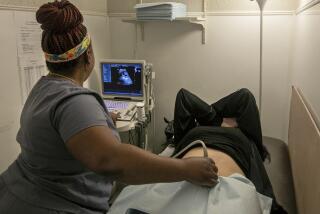Test IDs Risk of Pre-Term Deliveries
- Share via
An experimental test has identified certain pregnant women in danger of pre-term delivery--a discovery that researchers hope might eventually help reduce the stubbornly high rate of premature births in the United States.
The test, being tried at UC Irvine and other research sites, appears to offer the first reliable method of predicting which women are at high risk for pre-term delivery--without having to rely on such fallible predictors as a woman’s obstetrical history and overt symptoms.
“The test . . . is an encouraging step in our battle against pre-term delivery,” wrote Dr. Robert K. Creasy, an expert in the field, in an editorial accompanying a report on the test published today in the New England Journal of Medicine.
Pre-term delivery--that is, delivery before the completion of 37 weeks of gestation--is the leading cause of illness and death among newborns in the United States. About 400,000 babies are delivered prematurely each year; about 30,000 of them die.
Attempts to lower the rate of pre-term births have been stymied by the inability of physicians to predict which pregnancies are at risk. As a result, experts say, drugs that can avert premature labor are often ineffective because they are given inappropriately or too late.
For that reason, researchers have sought an objective, biochemical “marker” that might identify women at risk well in advance. According to the authors of the new report, several earlier supposed markers did not hold up under scrutiny.
The new test, being developed by a 5-year-old biotechnology firm in Sunnyvale, involves a protein called fetal fibronectin, which researchers believe is released as a result of damage to fetal membranes and thus might serve as a marker for impending delivery.
The test is said to be comparable to a Pap smear; it analyzes a woman’s vaginal and cervical secretions. Company officials say it would cost $25 to $50. It is undergoing further testing and has yet to be approved by the Food and Drug Administration.
In their study, researchers at UC Irvine, Mt. Sinai School of Medicine in New York City and Adeza Biomedical in Sunnyvale tried the test on women admitted to hospitals for either pre-term rupture of membranes or pre-term contractions with intact membranes.
The researchers found high levels of fetal fibronectin in 93.8% of the women with pre-term rupture of membranes. They found the protein in half of the women with apparently intact membranes, and they found that it predicted more than 80% of those who went on to deliver early.
The protein was rarely found in women with uncomplicated pregnancies.
“The key thing is at least it provides an avenue for research that may allow us to identify women at risk early enough to prevent delivery,” said Dr. Charles J. Lockwood, an assistant professor at Mt. Sinai and lead author of the paper.
The new test will make it possible to experiment with drug treatments on women most likely to benefit from them, said Dr. Thomas J. Garite of UC Irvine, a co-author. The inability to identify those women has made it difficult to design drug trials.
The effectiveness of the new test is also being studied in pregnant women with no evidence of complications. While that second study has yet to be published, Garite said preliminary findings suggest that the test may be an effective predictor in those women as well.
The researchers and others stressed that their new findings are preliminary and need to be confirmed. Furthermore, they said it remains to be seen whether identifying and treating high-risk women can prevent many deliveries.
“Although it is possible that identifying these patients could lead to meaningful therapeutic interventions, the mere identification of patients at risk does not necessarily result in improved outcomes,” they wrote in the study.
Another expert in the field, who asked not to be quoted by name, pointed out that pre-term birth is a complicated and multidimensional problem--”a social problem, a medical problem, a public health problem, a pandemic.”
As many as a quarter of all pre-term births result from deliveries necessary to protect the health or life of the mother or the fetus. Another third involve women with premature rupture of fetal membranes, after which it is difficult to prevent delivery.
That leaves one-third to one-half of all pre-term births that might, in theory, be preventable.






